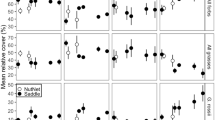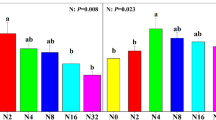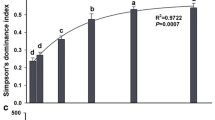Abstract
Repercussions of species loss on ecosystem processes depend on the effects of the lost species as well as the compensatory responses of the remaining species in the community. We experimentally removed two co-dominant plant species and added a 15N tracer in alpine tundra to compare how species’ functional differences influence community structure and N cycling. For both of the species, production compensated for the biomass removed by the second year. However, the responses of the remaining species depended on which species was removed. These differences in compensation influenced how species loss impacted ecosystem processes. After the removal of one of the co-dominant species, Acomastylis rossii, there were few changes in the relative abundance of the remaining species, and differences in functioning could be predicted based on effects associated with the removed species. In contrast, the removal of the other co-dominant, Deschampsia caespitosa, was associated with subsequent changes in community structure (species relative abundances and diversity) and impacts on ecosystem properties (microbial biomass N, dissolved organic N, and N uptake of subordinate species). Variation in compensation may contribute to the resulting effects on ecosystem functioning, with the potential to buffer or accelerate the effects of species loss.





Similar content being viewed by others
References
Aksenova AA, Onipchenko VG, Blinnikov MS (1998) Plant interactions in alpine tundra: 13 years of experimental removal of dominant species. Ecoscience 5:258–270
Allen EB, Forman RTT (1976) Plant species removals and old-field community structure and stability. Ecology 57:1233–1243
Baron JS, et al. (2000) Ecosystem responses to nitrogen deposition in the Colorado Front Range. Ecosystems 3:352–368
Bowman WD, Steltzer H (1998) Positive feedbacks to anthropogenic nitrogen deposition in Rocky Mountain alpine tundra. Ambio 27:514–517
Bowman WD, Theodose TA, Fisk MC (1995) Physiological and production responses of plant-growth forms to increases in limiting resources in alpine tundra—implications for differential community response to environmental-change. Oecologia 101:217–227
Bowman WD, Steltzer H, Rosenstiel TN, Cleveland CC, Meier CL (2004) Litter effects of two co-occurring alpine species on plant growth, microbial activity and immobilization of nitrogen. Oikos 104:336–344
Bret-Harte MS, et al. (2004) Plant and soil responses to neighbour removal and fertilization in Alaskan tussock tundra. J Ecol 92:635–647
Brookes PC, Landman A, Pruden G, Jenkinson DS (1985) Chloroform fumigation and the release of soil-nitrogen—a rapid direct extraction method to measure microbial biomass nitrogen in soil. Soil Biol Biochem 17:837–842
Buonopane M, Huenneke LF, Remmenga M (2005) Community response to removals of plant functional groups and species from a Chihuahuan desert shrubland. Oikos 110:67–80
Callaway RM, et al. (2002) Positive interactions among alpine plants increase with stress. Nature 417:844–848
Chapin FS (2003) Effects of plant traits on ecosystem and regional processes: a conceptual framework for predicting the consequences of global change. Ann Bot 91:455–463
Choler P, Michalet R, Callaway RM (2001) Facilitation and competition on gradients in alpine plant communities. Ecology 82:3295–3308
Craine JM, Tilman D, Wedin D, Reich P, Tjoelker M, Knops J (2002) Functional traits, productivity and effects on nitrogen cycling of 33 grassland species. Funct Ecol 16:563–574
Diaz S, Cabido M (2001) Vive la difference: plant functional diversity matters to ecosystem processes. Trends Ecol Evol 16:646–655
Diaz S, Cabido M, Casanoves F (1999) Functional implications of trait-environment linkages in plant communities. In: Weiher E, Keddy P (eds) Ecological assembly rules. Cambridge University Press, Cambridge, pp 338–362
Ehrenfeld JG (2003) Effects of exotic plant invasions on soil nutrient cycling processes. Ecosystems 6:503–523
Gerdol R, Brancaleoni L, Marchesini R, Bragazza L (2002) Nutrient and carbon relations in subalpine dwarf shrubs after neighbour removal or fertilization in northern Italy. Oecologia 130:476–483
Hobbie SE (1992) Effects of plant–species on nutrient cycling. Trends Ecol Evol 7:336–339
Hooper DU, et al. (2005) Effects of biodiversity on ecosystem functioning: a consensus of current knowledge and needs for future research. Ecol Monogr 75(1):3–35
Khan SA, Mulvaney RL, Brooks PD (1998) Diffusion methods for automated nitrogen-15 analysis using acidified disks. Soil Sci Soc Am J 62:406–412
Larsen TH, Williams NM, Kremin C (2005) Extinction order and altered community structure rapidly disrupt ecosystem functioning. Ecol Lett 8:538–547
Lavorel S, Garnier E (2002) Predicting changes in community composition and ecosystem functioning from plant traits: revisiting the Holy Grail. Funct Ecol 16:545–556
Lipson DA, Schmidt SK, Monson RK (1999) Links between microbial population dynamics and nitrogen availability in an alpine ecosystem. Ecology 80(5):1623–1631
Magurran AE (1988) Ecological diversity and its measurement. Princeton University Press, Princeton, N.J.
May DE, Webber PJ (1982) Spatial and temporal variation of the vegetation and its productivity, Niwot Ridge, Colorado. In: Halfpenny J (ed) Ecological studies in the Colorado Alpine: a festschrift for John W. Marr. Institute of Arctic and Alpine Research University of Colorado, Boulder, Colo., pp 35–62
Miller AE, Bowman WD (2002) Variation in nitrogen-15 natural abundance and nitrogen uptake traits among co-occurring alpine species: do species partition by nitrogen form? Oecologia 131:635–635
Nadelhoffer KJ, Fry B (1994) Nitrogen isotope studies in forest ecosystems. In: Lajtha K, Michener R (eds) Stable isotopes in ecology and environmental science. Blackwell, Oxford, pp 22–44
Naeem S, Wright JP (2003) Disentangling biodiversity effects on ecosystem functioning: deriving solutions to a seemingly insurmountable problem. Ecol Lett 6:567–579
Pinder JE (1975) Effects of species removal on an old-field plant community. Ecology 56:747–751
Ruesink JL, Srivastava DS (2001) Numerical and per capita responses to species loss: mechanisms maintaining ecosystem function in a community of stream insect detritivores. Oikos 93:221–234
Schlapfer F, Pfisterer AB, Schmid B (2005) Non-random species extinction and plant production: implications for ecosystem functioning. J Appl Ecol 42:13–24
Silander JA, Antonovics J (1982) Analysis of interspecific interactions in a coastal plant community—a perturbation approach. Nature 298:557–560
Smith MD, Knapp AK (2003) Dominant species maintain ecosystem function with non-random species loss. Ecol Lett 6:509–517
Stark JM, Hart SC (1996) Diffusion technique for preparing salt solutions, Kjeldahl digests, and persulfate digests for nitrogen-15 analysis. Soil Sci Soc Am J 60:1846–1855
Steltzer H, Bowman WD (1998) Differential influence of plant species on soil nitrogen transformations within moist meadow Alpine tundra. Ecosystems 1:464–474
Suding KN, Larson JR, Thorsos E, Steltzer H, Bowman WD (2004) Species effects on resource supply rates: do they influence competitive interactions? Plant Ecol 175:45–58
Suding KN, et al. (2005) Functional- and abundance-based mechanisms explain diversity loss due to N fertilization. Proc Natl Acad Sci USA 102:4387–4392
Symstad AJ, Tilman D (2001) Diversity loss, recruitment limitation, and ecosystem functioning: lessons learned from a removal experiment. Oikos 92:424–435
Symstad AJ, et al. (2003) Long-term and large-scale perspectives on the relationship between biodiversity and ecosystem functioning. Bioscience 53:89–98
Wardle DA, et al. (1999) Plant removals in perennial grassland: vegetation dynamics, decomposers, soil biodiversity, and ecosystem properties. Ecol Monogr 69:535–568
Weber W (1976) Rocky Mountain flora. University of Colorado Press, Niwot, Colo.
Williams MW, Tonnessen KA (2000) Critical loads for inorganic nitrogen deposition in the Colorado Front Range, USA. Ecol Appl 10:1648–1665
Williams MW, Baron JS, Caine N, Sommerfeld R, Sanford R (1996) Nitrogen saturation in the Rocky Mountains. Environ Sci Technol 30:640–646
Acknowledgements
This work was funded by the Andrew W. Mellon Foundation, with support from the Niwot Ridge Long-Term Ecological Research Program (NSF 0423662). We thank I. Ashton, R. Inouye, A. Kahmen, B. Schmid, and an anonymous reviewer for critical comments on this manuscript, E. Hayes, J. Larson, K. Lohnas, M. Talluto, and E. Thorsos for help in the field and laboratory, and C. Seibold for analytical support. The experiments comply with the current laws of the country in which they were performed.
Author information
Authors and Affiliations
Corresponding author
Additional information
Communicated by Bernhard Schmid
Rights and permissions
About this article
Cite this article
Suding, K.N., Miller, A.E., Bechtold, H. et al. The consequence of species loss on ecosystem nitrogen cycling depends on community compensation. Oecologia 149, 141–149 (2006). https://doi.org/10.1007/s00442-006-0421-4
Received:
Accepted:
Published:
Issue Date:
DOI: https://doi.org/10.1007/s00442-006-0421-4




